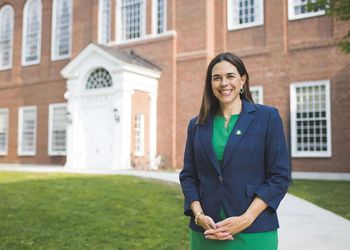Ex-Marine Researchers Test Power of Yoga

Last summer, former Marine scout sniper Logan Stark believed he was dealing pretty well with post-traumatic stress disorder (PTSD). Then a senior at MSU, he had made a hit documentary about his fallen comrades in Afghanistan, cycled in the six-day Ride 2 Recovery challenge and written cathartic articles for such publications as The New York Times and On Patrol.
But then Stark participated in a nine-week experiment on whether yoga can benefit veterans with PTSD, and his mental and emotional recovery “was taken to another level,” he said.
Not only that, but the study by MSU psychology researchers provided perhaps the first physiological evidence that yoga improves brain function of people with PTSD. Each week, following Stark’s yoga and meditation sessions with instructor Kintla Ernst, the researchers would outfit Stark with an electrode cap and measure his brain activity while he performed computer tasks.
“Logan’s brain efficiency jumped through the roof after two months of yoga,” said Jason Moser, assistant professor of psychology. “His memory improved, he was much less distracted and he was able to bounce back from mistakes with ease.”
Yoga, a 5,000-year-old spiritual practice aimed at achieving inner balance and harmony, is growing in popularity. Yoga participation in the United States jumped from 15.8 million in 2008 to 20.4 million in 2012, a 29 percent increase, according to a national survey. Previous research has shown that yoga can help reduce anxiety, depression and stress.
Ernst, of Kintla Yoga LLC in East Lansing, specializes in working with trauma survivors and said she was interested in helping facilitate a study on the healing powers of yoga in people with PTSD. She reached out to Moser, who previously worked with veterans at the Veterans Affairs National Center for Post-Traumatic Stress Disorder in Boston, and then recruited Stark as the study’s lone participant after reading about his war experiences from 2010.
Stark’s former unit, the 3rd Battalion, 5th Marines, suffered 25 casualties in Afghanistan. His film, For the 25, which has been viewed more than 665,000 times on YouTube, documents the brutalities of war and the reality of living with PTSD.
Watching friends die in battle can lead to grief, survivor’s guilt and depression. Stark said a natural human response is to mentally and emotionally distance oneself from those issues, creating a “disconnect” between mind and body.
Ernst said yoga can help trauma survivors “reconnect” to the here and now. While her sessions include traditional yoga postures, they are specially designed to empower healing. Rather than “just standing back and teaching,” Ernst offers the student choices, uses compassionate language and actively shares in the experience with the student.
“If you’re more aware of what’s going on around you, when a trigger comes up you can breathe deeply, come into the present and more skillfully handle what arises .… It’s about learning to be present in a safe space and discovering the magic of reconnecting body, mind and breath.” — Kintla Ernst
Stark, 27, of Greenville, had never practiced yoga and purposely did not research the discipline before starting, so he could go into the study with an open mind. It didn’t take long for him to become a believer; the two-hour sessions, he said, were highly effective in improving his flexibility, endurance, mindfulness, focus and patience.
“Every time I finished a session, I would walk away feeling so much better,” said Stark, who graduated in December with a bachelor’s degree in professional writing. “It’s almost like it becomes one of those things the body needs, like sleep.”
And, as Moser noted, Stark’s brain function improved as well.
Once a week Moser and psychology doctoral student Jeff Lin would run Stark through at least two hours of computer-based exercises, including a task that involved solving math problems while remembering a random sequence of letters. On this task, Stark improved significantly, going from a pre-yoga score of 22 (which reflects low ability to juggle multiple things in the mind) to a post-study score of 50 (which is within the range of high ability).
Stark’s reaction time improved dramatically on a timed task that measured distractibility. (The task involved identifying certain shapes while ignoring “distractor” shapes.) Stark’s improvement was remarkable, Moser said, because past research suggests that simply doing the task over and over does not improve performance.
“One could make an argument that yoga reduced Logan’s anxiety and increased his focus so the distractors captured less of his attention and he could perform more optimally,” Moser said.
Stark also improved on tasks that measured his reactions to mistakes and loud noises. And while much more research needs to be done on a possible connection between yoga and PTSD, Moser said he’s encouraged by the results.
“It’s a one-person study, that’s the caveat. However the depth of change we’re seeing across all fronts is truly remarkable.”
Contributing Writer(s): Andy Henion, Photos by Greg Kohuth



